AVRUPA İNSAN HAKLARI SÖZLEŞMESİNE EK PROTOKOLLER İLE GETİRİLEN YENİLİKLER
İnsan hak ve özgürlüklerinin etkili bir şekilde korunması amacıyla Avrupa İnsan Hakları Sözleşmesi 1950 yılında imzaya açılmıştır. Sözleşme 1953 yılında yürürlüğe girdiği tarihte sadece10 ülke taraf olduğu halde, bugün bu sayı 47 ülkeye ulaşmış ve 800 milyonu aşkın kişinin Sözleşme’de belirtilen hak ve özgürlükleri koruma altına alınmıştır.
İlk kabul edilişinden itibaren Sözleşme’de 16 Ek Protokol ile çok sayıda değişiklik yapılmıştır. Yapılan değişiklikler ile bir taraftan yeni hak ve özgürlükler Sözleşme kapsamında koruma altına alınırken, diğer taraftan koruma mekanizmalarına başvuru usulü basitleştirilmiş ve etkinliği artırılmıştır.
Sözleşme’nin ilk halinde Avrupa İnsan Hakları Komisyonu ve Avrupa İnsan Hakları Mahkemesi şeklinde ikili bir yapı öngörüldüğü halde, bugün Avrupa İnsan Hakları Mahkemesi Sözleşme kapsamında hem bireysel hem de devletlerarası başvuruları kabul etmekte ve sonuçlandırmaktadır. Mahkeme tarafından verilen kararların yerine getirilip getirilmediği ise Bakanlar Komitesi tarafından denetlenmekte ve böylelikle sistemin etkili bir şekilde işlemesi sağlanmaktadır.
Çalışmamızda öncelikle Sözleşmenin ilk hali incelenmiştir. Daha sonra ise 16 protokol ile getirilen değişiklikler ayrı ayrı belirtilmiştir. Ayrıca Sözleşme’de öngörülmemekle birlikte Mahkeme tarafından yorum yoluyla geliştirilen ve etkin bir şekilde uygulanmakta olan geçici tedbir, tek taraflı deklerasyon ve pilot dava usulü konuları da kısaca ele alınmıştır. Ayrıca gerek Mahkeme ve gerekse de Bakanlar Komitesi istatistiklerine de genel olarak yer verilmiştir. Böylelikle Sözleşme koruma sisteminin etkinliğinin artırılması amacıyla zaman içerisinde yapılan değişikliklerin anlaşılmasına katkı sağlanmak istenilmiştir.
Anahtar Kelimeler:
Avrupa İnsan Hakları Sözleşmesi, Ek Protokol, Avrupa İnsan Hakları Mahkemesi, bireysel başvuru, devletlerarası başvuru
Novelties Brought by Additional Protocols to the European Convention on Human Rights
European Convention on Human Rights has been opened for signature in 1950 in order to protect human rights and freedoms in an effective way. While only 10 countries had been party when the Convention entered into force in 1953, the number of the high contracting parties has been reached to 47 and the rights and freedoms defined in the Convention of more than 800 million individuals have taken under protection.
Many amendments in the Convention have been made with 16 additional Protocols since its first adoption. With these amendments on the one hand the new rights and freedoms have been taken under protection, on the other hand the procedure of the application to the protection mechanism has been simplified and its effectiveness has been increased.
Although the two tier structure namely the European Commission of Human Rights and the European Court of Human Rights has been foreseen in the original version of the Convention, the Court deals with both individual and interstate applications within the Convention today. Whether the judgements given by the Court execute or not is being supervised by the Committee of Ministers so that it ensures the effective functioning of the system.
The original version of the Convention is examined first in the study. Then the amendments brought by all 16 Protocols is stated separately. In addition, some novelties even though not defined in the Convention but implemented effectively brought by the case law of the Court such as interim measures, unilateral declarations and the procedure of the pilot judgement are discussed in brief. Besides statistics of the Court and the Committee of Ministers are examined in general. In conclusion, it is aimed at contributing to understand the amendments taken place over a period of time to increase the effectiveness of the Convention Protection System.
Keywords:
European Convention on Human Rights, Additional Protocols, European Court of Human Rights, individual application, interstate application,
___
- https://sgb.adalet.gov.tr/Resimler/SayfaDokuman/24122019093355stratejikplan.pdf
- https://www.coe.int/en/web/conventions/home
- https://www.echr.coe.int/Pages/home.aspx?p=home
- https://www.echr.coe.int/Documents/Stats_art_39_01_ENG.pdf
- https://www.echr.coe.int/Documents/Archives_1950_Convention_ENG.pdf
- https://www.echr.coe.int/Documents/Convention_Instrument_ENG.pdf
- https://www.echr.coe.int/Documents/Overview_19592020_ENG.pdf
- https://www.echr.coe.int/Documents/Annual_report_2020_ENG.pdf
- https://www.echr.coe.int/Documents/FS_Interim_measures_ENG.pdf
- https://www.echr.coe.int/Documents/FS_Pilot_judgments_ENG.pdf
- https://www.coe.int/en/web/human-rights-intergovernmental-cooperation
- https://www.coe.int/en/web/execution/country-factsheets
- https://rm.coe.int/2020-cm-annual-report-eng/1680a1f4e8
- https://rm.coe.int/tur-eng-fs4/1680709767
- https://www.ohchr.org/en/hrbodies/hrc/pages/home.aspx
- https://www.achpr.org/legalinstruments/detail?id=49
- https://treaties.un.org/pages/showdetails.aspx?objid=08000002800f10e1
- https://www.ohchr.org/EN/ProfessionalInterest/Pages/CCPR.aspx
- https://www.youtube.com/watch?v=Rq8vZUJZFHg
- ISSN: 1309-6826
- Başlangıç: 2010
- Yayıncı: Türkiye Adalet Akademisi
Sayıdaki Diğer Makaleler
TÜKETİCİ UYUŞMAZLIKLARININ ÇÖZÜMÜNDE ÖZEL DAVA ŞARTLARI VE İLAMSIZ İCRA TAKİBİ
OTOPARK, OTOPARK BEDELİ VE BU BEDELİN TAHSİL ZAMANAŞIMINA İLİŞKİN BİR İNCELEME
Emre AKBULUT, Maviş Esra YARALI, Ömer Faruk ÖZDEMİR
DEVLETLERİN ÖZEN YÜKÜMLÜLÜĞÜ İLKESİ BAĞLAMINDA DENİZLERDE GÖÇMENLERİ KORUMA GÖREVİ
ANAYASA MAHKEMESİ KARARLARINDA (İDARİ YARGI BAĞLAMINDA) GEREKÇELİ KARAR ALMA HAKKI
AVRUPA İNSAN HAKLARI SÖZLEŞMESİNE EK PROTOKOLLER İLE GETİRİLEN YENİLİKLER
ALEXIS DE TOCQUEVILLE’İN SİYASİ KURAMINDA DEMOKRASİ VE YARGI
